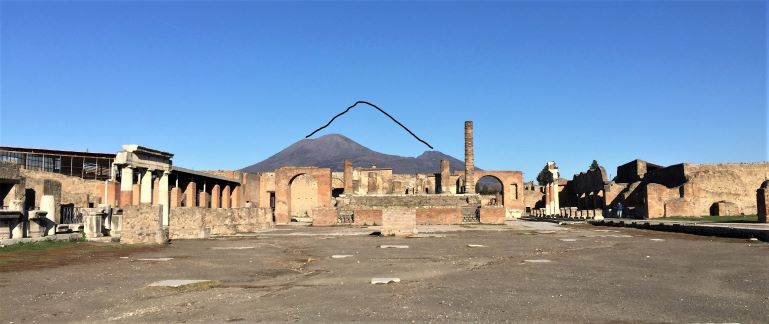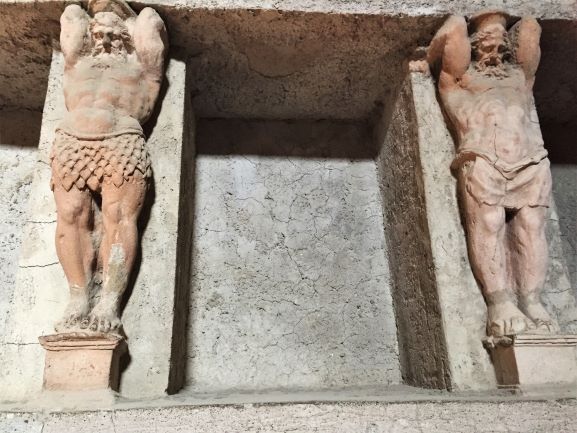In keeping with my life theme of not preparing anything ever and doing absolutely no research into my destinations, Pompeii was not what I expected. What I expected was a few old buildings, what I got was a history lesson and my mind BLOWN. (You can imagine this regularly happens when I never plan or research anything though. Go through life with very low expectations and you’ll always be pleased with the outcome).
Now I’ll put my history hat on (it’s the grey one with fluffy ears) and I’ll tell you a story all about how, Pompeii got buried, 15 feet down. And I’d like to take a minute, just sit right there, I’ll tell you how it became lost for thousands of years.
(OK, sorry, I’m done)
Vesuvius & Pompeii
When I walked into Pompeii, the first thing I noticed was Vesuvius.

Now, with the benefit of hindsight, we can say that it ominously looms over the ruined city, but at the time it was a pretty backdrop to this bustling city, which was surrounded by arable land and large areas of vineyards. You can see, with my amazing photoshop skills, I’ve added what the mountain would have looked like pre-explosion. Italy has always been seismically active, and records have shown that Pompeii often had varying sizes of eathquakes. The smaller ones were ‘normal’ and thus ignored but there was a shake in 62 AD that was around 5 on the Richter scale that caused damage and some people got a bit of a fright moved away from the area.
So, arguably some time in November 79 AD, Vesuvius erupted. Most of the 20,000 residents of Pompeii fled, but about 2,000 people didn’t leave, and likely died from an extreme surge of heat, a blast of hot air about 250oC. This is probably far kinder than being suffocated to death by the ash as originally thought. Over the course of the eruption, about six meters of ash fell on Pompeii, burying the city.
The city was buried so deeply, it was abandoned, and then forgotten. In 1599, it was rediscovered when an underground channel was being dug in the area. A local architect called Domenico Fontana was brought in. He uncovered some frescoes, and then re-buried them. While some people thought he might have been trying to preserve the ruins, it’s likely he was horrified by the sexual content of the art and censored it out of existence. In a way, it was good he did because it kept it safe for longer- more of the history may have been destroyed by prudish moral crusaders.
Then in 1748, after discovering nearby Herculaneum, Pompeii was intentionally excavated. in 1863, a chap called Giuseppe Fiorelli took over the site. Occasionally they would come across hollows in the ash layer. Fiorelli realised these were the voids left after human remains rotted away. He came up with a new technique where he injected the voids with plaster, so he could create replicas of the bodies.

I think the most startling one (on site, there are more in a Naples museum) was the man, getting up or lying down, resting on his elbow. To have died so quickly and then remain in this position as the ash fell around his body is indicative of how immediate his death was.
We had only allocated a morning for Pompeii and I wish we could have stayed longer. It is filled with amazing remnants of life 2000 years ago. To see how civilised and modern these people were makes me think that as a race, we’ve actually gone backwards…
There were fast food stores. No-one cooked at home, so you popped down the street to buy your food from the McDonalds and KFC of the day. Long benches have round hollows in them where the food sat in large containers, like a buffet. There were bakeries, with giant grinders to finely mill the wheat, and ovens to cook the bread. There were brothels, public bathing houses, streets made to accommodate either one way or two way traffic. There were water systems, temples, art, and unbelievable wealth. Somehow, here in 2018, we don’t seem that much more advanced in many ways.


Please note, the full sun (so hard to take photos in!) and my hat/ scarf/ jacket. It was cold. Although I like the lack of tourists, travel in winter is not without cold fingers.




These guys are holding up the ceiling here… such detail!



Apparently, the large penis signifies fertility…

The roads were paved, and the local chariots all had the same size axles. The raised stones were used as stepping stones by pedestrians when the roads were flooded each day to clean them.


It’s EASY to get here, just take the Circumvesuviana train from wherever, it drops you off basically opposite the entry. There’s a pizza place inside, and a heap of wee shops outside the main entry gate.
Positano of the perfect views
That afternoon, we went South. The Circumvesuviana took us to Sorrento, where we caught a bus the rest of the way to Positano. We got off a little early and walked down, there were plenty of roads and paths that took us down. It’s a beautiful area, with houses nestled into the hillside, coloured in a variety of hues. Positano is the first of these villages, there are more around the coast but sadly we didn’t get there in time. As a result we don’t recommend Pompeii and Positano be attempted in the same day… take a day and do the whole coastline, from Positano to Almalfi.






Someone else put these pebbles here and it seemed like a good idea 🙂


